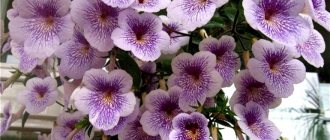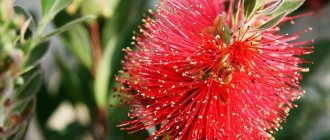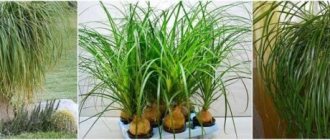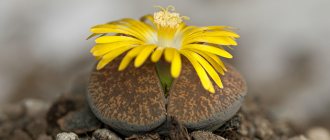Gloriosa belongs to the group of the most attractive plants that feel great indoors. This vine develops from tubers and climbs, creating an original combination of rich green foliage with uniquely beautiful petals, similar in appearance to flames.
Indoor Gloriosa is quite demanding to care for, but if you can create comfortable growing conditions, the beautiful flowers will decorate your home.
Description of the plant
The herbaceous perennial is a member of the Melantiaceae family. It is a climbing vine with rhizomes in the form of tubers. Thin and fragile shoots are characterized by flexibility. Gloriosa grows up to 2 m; its dimensions are influenced by the method of decorative formation and the type of support used.
The leaves have a glossy bright green color. In shape, they belong to the category of broadly lanceolate and entire. They have an elongated ending. They are usually arranged oppositely, sometimes in threes.
The leaf axils are the source of the appearance of peduncles, on which there are 2 flowers, similar in appearance to lilies. The perianths have a rich orange hue and grow up to 10 cm. There is an original yellow border along the edges.
The resemblance to flames is given by the dynamics of the development of flowers - at first they are yellow, but then gradually turn red, as can be seen in the photo of gloriosa.
Characterized by long flowering throughout spring, summer and autumn. As soon as some flowers fade, more buds form in their place. In total, from 4 to 7 buds appear on the stems.
The most popular plant varieties are:
- Gloriosa splendor is the most beautiful flowering plant.
- Gloriosa Rothschild with highly branched climbing shoots and fiery red petals.
- Gloriosa is simple with vines up to 1.5 m long, large pointed leaves, yellow flower petals, decorated with a greenish tint and red streaks.
Interesting Facts
- According to legend, a flower from the tropical zone of the Asian and African continents came to Europe thanks to the Queen of England. During her trip to Rhodesia, Elizabeth II was presented with a precious brooch in the form of a gloriosa. The flower I liked, by royal command, ended up in the British Isles, and then conquered the rest of Europe.
- In some parts of India and Thailand, the flower is so popular that it has become one of the elements of the state emblem. In Zimbabwe, the gloriosa plant has become a national symbol.
- Since ancient times, the poisonous properties of the flower were known to the natives, and they extracted juice from the tubers of the flower, and, like the character in Pushkin’s “Anchar,” they impregnated their arrows with poison.
- The flower is considered a wonderful gift for a man going to the battlefield. According to ancient beliefs, his presence brings good luck to warriors.
- In Australia, the flower adapted so well to local conditions that it began to reproduce with incredible speed, displacing endemic plants. The country is fighting it like a nasty weed.
Important! Despite all the attractiveness and beauty of the plant, if there are small children in the house who like to taste various indoor plants, growing Gloriosa is strictly prohibited. Pets can also suffer from the poison of the flower.
Lighting
Gloriuosa loves bright light, so she needs to create conditions with good lighting. True, the best option would be to place it on window sills with an eastern or western orientation. If you place it on windows facing south, then the midday sun can be harmful. Shading can cause stretching of shoots and lack of flowering.
Temperature
The flower should be kept at 20-25°C. This mode is most suitable for the spring-autumn period. This is the time of active plant development. With the beginning of dormancy, the tuber is dug up; it must be kept in cool conditions at 12-15 ° C.
With the arrival of spring, the plant begins to come to life. Shoots appear on the tuber. Therefore, it is necessary to slowly and gradually increase the temperature. You can’t suddenly move it to a warm place or a hot room - this will have a detrimental effect on gloriosis.
Humidity
The plant is moisture-loving, so increased air humidity parameters are desirable. For this, both standard humidifiers and trays with moistened moss are used. You can put pebbles or expanded clay in the trays along with water.
Spraying should be done regularly. Soft water is suitable. Its temperature should be close to room temperature. Spray carefully during flowering - water should not come into contact with the buds that have blossomed. Otherwise, there is a high risk of losing flowers.
Briefly about cultivation
- Flowering: from June to August.
- Lighting: bright diffused light.
- Temperature: during the growing season – 20-25 ºC. In autumn, tubers are dug up and stored until spring at a temperature of 8-10 ºC.
- Watering: during the growing season - plentiful, after the top layer of soil has dried: the earthen ball should be slightly moist all the time.
- Humidity: high. Daily spraying is required, but water should not get on the flowers. It is better to keep the plant on a tray with wet expanded clay.
- Feeding: during the growing season - once every two weeks with liquid fertilizer for flowering indoor plants. In winter, fertilizing is not needed.
- Support: The vine needs support, which is fixed in the pot when planting.
- Transplantation: after storage, tubers are planted annually in spring - early March.
- Substrate: four parts humus soil, two parts leafy soil and half each peat and sand.
- Reproduction: seeds and tubers.
- Pests: scale insects.
- Diseases: powdery mildew and problems due to improper care.
- Properties: Gloriosa tubers are poisonous!
Read more about growing gloriosa below.
Features of transplantation
After leaving the dormant stage, the tuber is transplanted into new soil. Place it in a horizontal orientation to the plane. The top of the tuber should be sprinkled with 2-3 cm of substrate. This part is very fragile. It should be protected, avoiding damage to the growth bud at the tuberous tip.
They are usually transplanted into wide containers with shallow depth. It is advisable to use clay pots and avoid plastic utensils. A drainage pad is laid out at the bottom.
It is advisable to replant in the last days of winter or early spring. The transplanted flower should be kept at 15-20°C, regularly moistening the substrate. After the formation of the first green leaves, it is advisable to ensure adaptation to light.
Providing peace
As soon as the leaves begin to turn yellow in September and the stems dry out, watering should be stopped. This is how the plant signals the transition to the dormant stage. With good watering of the flower, the tuber turns out to be large. The root crop is stored as follows:
Without removing it from the substrate, you should place the pot in a dark place. The temperature should be room temperature. Avoid proximity to heat sources. Replanting into new soil should be done in February or in the first ten days of March. The speed of revival is 2 weeks.
The tuber is removed from the substrate and placed in peat placed in a box for the autumn-winter season. You can also use well-dried sand. The container is tightly closed and transferred to the refrigerator at 8-12°C.
Caring for Gloriosa at home
It is best to purchase the plant in specialized stores. For sale, indoor flowers are grown in special greenhouses under conditions of high humidity and air temperature. Without preliminary hardening, the plant most often dies or begins to get sick. In flower shops, crops undergo this procedure and therefore can more easily withstand moving and new conditions. The leaves of the selected plant must be healthy, free from pests and signs of disease. The stem is evenly leafy, succulent, with green leaves. Does Gloriosa prefer careful or unpretentious care? This question is often asked by beginning gardeners.
The plant is not capricious, the maintenance of the flower consists of systematic moderate watering of the indoor plant, providing warm diffused light, and maintaining a comfortable air temperature.
Every year in the fall, the luxurious Gloriosa suffers the death of the above-ground part, leaving white-brown rhizomes or long “carrots” to overwinter in the home greenhouse.
After the shoots die, in the absence of watering, the roots can be stored at room temperature. In February, Gloriosa splendor tubers are ready for germination.
Location and lighting
Lighting is one of the most important factors in the development of indoor crops. Under the influence of sunlight, the process of photosynthesis occurs in the leaves, and when there is insufficient lighting, they become too pale and dull. However, too intense light can be harmful to the plant. It often causes brown and gray spots to appear on the leaves - sunburn.
Each culture has its own requirements for light conditions, and often several species of the same genus may prefer lighting of different intensity.
Gloriosa requires a bright, sunny, warm place. In summer, it should be protected from direct sunlight; you can take it out into the fresh air, onto a balcony or loggia and tie the shoots to a support.
Temperature
In the room where gloriosis develops during the growing season, the temperature must be maintained at least +16 degrees.
Air humidity
Gloriosa requires high humidity. It is necessary to carefully spray the plant daily, but only so that the water does not come into contact with the flowers, since moisture can cause stains to appear, which will spoil the decorative appeal of the crop.
Watering
Without exception, all indoor crops require watering, since without water they inevitably die. Water is of great importance for all plant life processes: photosynthesis, absorption and movement of minerals, temperature regulation. Not only a lack of water, but also an excess of water is detrimental to plants.
If watering is too frequent and abundant, water blocks air access to the roots, and the roots begin to rot.
In summer, watering should be normal, the soil should remain evenly moist. It should not be over-watered, otherwise the tubers may rot. In autumn, watering is reduced, and after the leaves die off, it is stopped completely. When the plant has finished blooming, you should wait until the leaves wither and fall off. After this, the tuber is left in the pot and kept all winter without watering.
Feeding and fertilizers
During the period of active growth until late summer, liquid fertilizer with a high potash content should be applied every 1-2 weeks.
Garter
The gloriosa flower, as mentioned above, holds onto its support with the help of tendrils located at the ends of the leaves. The stem is tender and brittle. To avoid breaking the stem, it must be tied up.
Using tubers
When babies appear, they are carefully cut off and transferred to containers 13-16 cm in diameter. The soil is prepared by mixing turf and leaf type soil, humus with sand in a combination of 1:2:2:0.5. The root crop has one growth point. It should be on top. Cover the tuber with a substrate 3 cm thick.
- Home gerbera: how to grow and care for it correctly? 130 photos of flowers and tips for keeping them indoors
Achimenes: care, growing indoor flowers and tips on choosing them for planting (115 photos + video)
- Bathroom renovation ideas
The optimal growth regime will be 22-24°C. Water the young plant after young shoots appear. Support is provided for weak stems. As the root system develops, larger containers are selected.
Garter
Like any liana, the gloriosa indoor plant needs support. The stems of the plant are very tender and brittle. A garter to a support will help protect the stems from fractures during growth.
Important! The stakes for the garter must be thin so that the plant's tendrils can securely cling to them!
Planting seeds
This is a more labor-intensive method. First you need to pollinate the plant using a cotton swab. Once the seeds are collected, they should not be stored. Planting Gloriosa is done quickly. To do this, you need to take a substrate that includes peat with turf soil and sand in equal parts.
Planted seeds are kept in small greenhouses at 22°C and above. Regular ventilation is required. After the sprouts appear, they are thinned out, and then the seedlings are picked. Flowers form after 3 years.
The soil
The best soil for the plant is considered to be a mixture consisting of equal parts of peat, turf and soil. All this can be prepared at home.
Another option is to purchase a universal flower primer at the store. The addition of lamellar crystals of vermiculite, polystyrene foam and crushed bricks helps to impart the necessary looseness.
Pests and diseases
Damage to the flower is caused by scale insects, aphids, and non-compliance with maintenance conditions:
- with a lack of light, low temperatures or problems with the tuber, the formation of leaves and flowers is delayed;
- the appearance of limp leaves or their darkening, slowing of stem growth is provoked by temperature changes;
- insufficient humidity leads to yellow foliage and dry tips;
- excess moisture and rotting cause yellowness of the base of the leaves and lethargy of the stems;
- white coating on the leaves is the result of a violation of the humidity regime.
Gloriosa is a poisonous plant. Therefore, exclude children from contact with it, and carry out all work with gloves.
Watering
Like any plant, the tropical beauty requires water; without it, Gloriosa will die. In summer, the soil in the pot should be moderately moist. A large amount of moisture blocks the access of oxygen to the roots, and they can rot.
In autumn, the regularity of watering decreases, and after the leaves have fallen, the flower should not be watered.











